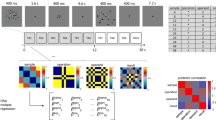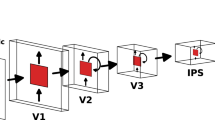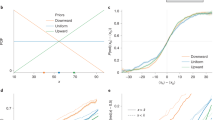Abstract
Whether small numerical quantities are represented by a special subitizing system that is distinct from a large-number estimation system has been debated for over a century. Here we show that two separate neural mechanisms underlie the representation of small and large numbers. We performed single neuron recordings in the medial temporal lobe of neurosurgical patients judging numbers. We found a boundary in neuronal coding around number 4 that correlates with the behavioural transition from subitizing to estimation. In the subitizing range, neurons showed superior tuning selectivity accompanied by suppression effects suggestive of surround inhibition as a selectivity-increasing mechanism. In contrast, tuning selectivity decreased with increasing numbers beyond 4, characterizing a ratio-dependent number estimation system. The two systems with the coding boundary separating them were also indicated using decoding and clustering analyses. The identified small-number subitizing system could be linked to attention and working memory that show comparable capacity limitations.
This is a preview of subscription content, access via your institution
Access options
Access Nature and 54 other Nature Portfolio journals
Get Nature+, our best-value online-access subscription
$29.99 / 30 days
cancel any time
Subscribe to this journal
Receive 12 digital issues and online access to articles
$119.00 per year
only $9.92 per issue
Buy this article
- Purchase on Springer Link
- Instant access to full article PDF
Prices may be subject to local taxes which are calculated during checkout





Similar content being viewed by others
Data availability
The data associated with this study are publicly available at https://github.com/EstherKutter/Distinct-Neuronal-Representation-Of-Small-And-Large-Numbers-In-The-Human-MTL.
Code availability
The custom code associated with this study is publicly available at https://github.com/EstherKutter/Distinct-Neuronal-Representation-Of-Small-And-Large-Numbers-In-The-Human-MTL.
References
Jevons, W. S. The power of numerical discrimination. Nature 3, 281–282 (1871).
Kaufman, E. L., Lord, M. W., Reese, T. W. & Volkmann, J. The discrimination of visual number. Am. J. Psychol. 62, 498–525 (1949).
Mandler, G. & Shebo, B. J. Subitizing: an analysis of its component processes. J. Exp. Psychol. Gen. 111, 1–22 (1982).
Feigenson, L., Dehaene, S. & Spelke, E. Core systems of number. Trends Cogn. Sci. 8, 307–314 (2004).
Anobile, G., Cicchini, G. M. & Burr, D. C. Number as a primary perceptual attribute: a review. Perception 45, 5–31 (2016).
Cheyette, S. J. & Piantadosi, S. T. A unified account of numerosity perception. Nat. Hum. Behav. 4, 1265–1272 (2020).
Tsouli, A. et al. The role of neural tuning in quantity perception. Trends Cogn. Sci. 26, 11–24 (2022).
Piazza, M., Mechelli, A., Butterworth, B. & Price, C. J. Are subitizing and counting implemented as separate or functionally overlapping processes? NeuroImage 15, 435–446 (2002).
Libertus, M. E., Woldorff, M. G. & Brannon, E. M. Electrophysiological evidence for notation independence in numerical processing. Behav. Brain Funct. 3, 1 (2007).
Harvey, B. M., Klein, B. P., Petridou, N. & Dumoulin, S. O. Topographic representation of numerosity in the human parietal cortex. Science 341, 1123–1126 (2013).
Fornaciai, M. & Park, J. Decoding of electroencephalogram signals shows no evidence of a neural signature for subitizing in sequential numerosity. J. Cogn. Neurosci. 33, 1535–1548 (2021).
Cai, Y. et al. Topographic numerosity maps cover subitizing and estimation ranges. Nat. Commun. 12, 3374 (2021).
Sathian, K. et al. Neural evidence linking visual object enumeration and attention. J. Cogn. Neurosci. 11, 36–51 (1999).
Fink, G. R. et al. Deriving numerosity and shape from identical visual displays. NeuroImage 13, 46–55 (2001).
Hyde, D. C. & Spelke, E. S. All numbers are not equal: an electrophysiological investigation of small and large number representations. J. Cogn. Neurosci. 21, 1039–1053 (2009).
Kutter, E. F., Bostroem, J., Elger, C. E., Mormann, F. & Nieder, A. Single neurons in the human brain encode numbers. Neuron 100, 753–761.e4 (2018).
Kutter, E. F., Boström, J., Elger, C. E., Nieder, A. & Mormann, F. Neuronal codes for arithmetic rule processing in the human brain. Curr. Biol. 32, 1275–1284.e4 (2022).
Leibovich-Raveh, T., Lewis, D. J., Kadhim, S. A. R. & Ansari, D. A new method for calculating individual subitizing ranges. J. Numer. Cogn. 4, 429–447 (2018).
Atkinson, J., Campbell, F. W. & Francis, M. R. The magic number 4 ± 0: a new look at visual numerosity judgements. Perception 5, 327–334 (1976).
Simon, T. J. & Vaishnavi, S. Subitizing and counting depend on different attentional mechanisms: evidence from visual enumeration in afterimages. Percept. Psychophys. 58, 915–926 (1996).
Sengupta, R., Surampudi, B. R. & Melcher, D. A visual sense of number emerges from the dynamics of a recurrent on-center off-surround neural network. Brain Res. 1582, 114–124 (2014).
Sengupta, R., Bapiraju, S. & Melcher, D. Big and small numbers: empirical support for a single, flexible mechanism for numerosity perception. Atten. Percept. Psychophys. 79, 253–266 (2017).
Fias, W. Two routes for the processing of verbal numbers: evidence from the SNARC effect. Psychol. Res. 65, 250–259 (2001).
Nuerk, H.-C., Iversen, W. & Willmes, K. Notational modulation of the SNARC and the MARC (linguistic markedness of response codes) effect. Q. J. Exp. Psychol. A 57, 835–863 (2004).
Nieder, A. Representing something out of nothing: the dawning of zero. Trends Cogn. Sci. 20, 830–842 (2016).
Schoups, A., Vogels, R., Qian, N. & Orban, G. Practising orientation identification improves orientation coding in V1 neurons. Nature 412, 549–553 (2001).
Yang, T. & Maunsell, J. H. R. The effect of perceptual learning on neuronal responses in monkey visual area V4. J. Neurosci. 24, 1617–1626 (2004).
Lee, S. H. et al. Activation of specific interneurons improves V1 feature selectivity and visual perception. Nature 488, 379–383 (2012).
Nieder, A. & Miller, E. K. Coding of cognitive magnitude: compressed scaling of numerical information in the primate prefrontal cortex. Neuron 37, 149–157 (2003).
Saxena, S. & Cunningham, J. P. Towards the neural population doctrine. Curr. Opin. Neurobiol. 55, 103–111 (2019).
Caliński, T. & Harabasz, J. A dendrite method for cluster analysis. Commun. Stat. 3, 1–27 (1974).
Tibshirani, R., Walther, G. & Hastie, T. Estimating the number of clusters in a data set via the gap statistic. J. R. Stat. Soc. Ser. B 63, 411–423 (2001).
Lloyd, S. Least squares quantization in PCM. IEEE Trans. Inf. Theory 28, 129–137 (1982).
Viswanathan, P. & Nieder, A. Differential impact of behavioral relevance on quantity coding in primate frontal and parietal neurons. Curr. Biol. 25, 1259–1269 (2015).
Ramirez-Cardenas, A., Moskaleva, M. & Nieder, A. Neuronal representation of numerosity zero in the primate parieto-frontal number network. Curr. Biol. 26, 1285–1294 (2016).
Viswanathan, P. & Nieder, A. Spatial neuronal integration supports a global representation of visual numerosity in primate association cortices. J. Cogn. Neurosci. 32, 1184–1197 (2020).
Hartline, H. K., Wagner, H. G. & Ratliff, F. Inhibition in the eye of Limulus. J. Gen. Physiol. 39, 651–673 (1956).
Isaacson, J. S. & Scanziani, M. How inhibition shapes cortical activity. Neuron 72, 231–243 (2011).
Diester, I. & Nieder, A. Complementary contributions of prefrontal neuron classes in abstract numerical categorization. J. Neurosci. 28, 7737–7747 (2008).
Ditz, H. M., Fechner, J. & Nieder, A. Cell-type specific pallial circuits shape categorical tuning responses in the crow telencephalon. Commun. Biol. 5, 269 (2022).
Angelucci, A. & Bressloff, P. C. Contribution of feedforward, lateral and feedback connections to the classical receptive field center and extra-classical receptive field surround of primate V1 neurons. Prog. Brain Res. 154, 93–120 (2006).
Bair, W., Cavanaugh, J. R. & Movshon, J. A. Time course and time–distance relationships for surround suppression in macaque V1 neurons. J. Neurosci. 23, 7690–7701 (2003).
Nassi, J. J., Lomber, S. G. & Born, R. T. Corticocortical feedback contributes to surround suppression in V1 of the alert primate. J. Neurosci. 33, 8504–8517 (2013).
Ison, M. J. et al. Selectivity of pyramidal cells and interneurons in the human medial temporal lobe. J. Neurophysiol. 106, 1713–1721 (2011).
Gast, H. et al. Burst firing of single neurons in the human medial temporal lobe changes before epileptic seizures. Clin. Neurophysiol. 127, 3329–3334 (2016).
Mosher, C. P. et al. Cellular classes in the human brain revealed in vivo by heartbeat-related modulation of the extracellular action potential waveform. Cell Rep. 30, 3536–3551.e6 (2020).
Railo, H., Koivisto, M., Revonsuo, A. & Hannula, M. M. The role of attention in subitizing. Cognition 107, 82–104 (2008).
Vetter, P., Butterworth, B. & Bahrami, B. Modulating attentional load affects numerosity estimation: evidence against a pre-attentive subitizing mechanism. PLoS ONE 3, e3269 (2008).
Burr, D. C., Turi, M. & Anobile, G. Subitizing but not estimation of numerosity requires attentional resources. J. Vis. 10, 20 (2010).
Luck, S. J. & Vogel, E. K. The capacity of visual working memory for features and conjunctions. Nature 390, 279–281 (1997).
Cowan, N. The magical number 4 in short-term memory: a reconsideration of mental storage capacity. Behav. Brain Sci. 24, 87–114 (2001).
Piazza, M., Fumarola, A., Chinello, A. & Melcher, D. Subitizing reflects visuo-spatial object individuation capacity. Cognition 121, 147–153 (2011).
Wang, X.-J., Tegnér, J., Constantinidis, C. & Goldman-Rakic, P. S. Division of labor among distinct subtypes of inhibitory neurons in a cortical microcircuit of working memory. Proc. Natl Acad. Sci. USA 101, 1368–1373 (2004).
Störmer, V. S. & Alvarez, G. A. Feature-based attention elicits surround suppression in feature space. Curr. Biol. 24, 1985–1988 (2014).
Kiyonaga, A. & Egner, T. Center-surround inhibition in working memory. Curr. Biol. 26, 64–68 (2016).
Müller, N. G. & Kleinschmidt, A. The attentional ‘spotlight’s’ penumbra: center-surround modulation in striate cortex. NeuroReport 15, 977–980 (2004).
Hopf, J.-M. et al. Direct neurophysiological evidence for spatial suppression surrounding the focus of attention in vision. Proc. Natl Acad. Sci. USA 103, 1053–1058 (2006).
Sundberg, K. A., Mitchell, J. F. & Reynolds, J. H. Spatial attention modulates center-surround interactions in macaque visual area v4. Neuron 61, 952–963 (2009).
Anton-Erxleben, K., Stephan, V. M. & Treue, S. Attention reshapes center-surround receptive field structure in macaque cortical area MT. Cereb. Cortex 19, 2466–2478 (2009).
Nieder, A., Freedman, D. J. & Miller, E. K. Representation of the quantity of visual items in the primate prefrontal cortex. Science 297, 1708–1711 (2002).
Nieder, A. & Merten, K. A labeled-line code for small and large numerosities in the monkey prefrontal cortex. J. Neurosci. 27, 5986–5993 (2007).
Ditz, H. M. & Nieder, A. Neurons selective to the number of visual items in the corvid songbird endbrain. Proc. Natl Acad. Sci. USA 112, 7827–7832 (2015).
Ditz, H. M. & Nieder, A. Format-dependent and format-independent representation of sequential and simultaneous numerosity in the crow endbrain. Nat. Commun. 11, 686 (2020).
Niediek, J., Boström, J., Elger, C. E. & Mormann, F. Reliable analysis of single-unit recordings from the human brain under noisy conditions: tracking neurons over hours. PLoS ONE 11, e0166598 (2016).
Brainard, D. H. The Psychophysics Toolbox. Spat. Vis. 10, 433–436 (1997).
Pelli, D. G. The VideoToolbox software for visual psychophysics: transforming numbers into movies. Spat. Vis. 10, 437–442 (1997).
Kleiner, M., Brainard, D. & Pelli, D. What’s new in Psychtoolbox-3? Perception 36, 14 (2007).
Maris, E. & Oostenveld, R. Nonparametric statistical testing of EEG- and MEG-data. J. Neurosci. Methods 164, 177–190 (2007).
Mantel, N. & Haenszel, W. Statistical aspects of the analysis of data from retrospective studies of disease. J. Natl Cancer Inst. 22, 719–748 (1959).
Somes, G. W. The generalized Mantel–Haenszel statistic. Am. Stat. 40, 106–108 (1986).
Mormann, F. et al. Neurons in the human amygdala encode face identity, but not gaze direction. Nat. Neurosci. 18, 1568–1570 (2015).
Chang, C.-C. & Lin, C.-J. LIBSVM: a library for support vector machines. ACM Trans. Intell. Syst. Technol. 102, 1–27 (2011).
Yu, B. M. et al. Gaussian-process factor analysis for low-dimensional single-trial analysis of neural population activity. J. Neurophysiol. 102, 614–635 (2009).
Acknowledgements
We thank all patients for their participation. This research was supported by the German Research Council (Mo 930/4-2, SPP 2205, SPP 2411, SFB 1089; Ni 618/11-1, SPP 2205), the BMBF (031L0197B) and a NRW Network Grant (iBehave). The funders had no role in study design, data collection and analysis, decision to publish or preparation of the manuscript.
Author information
Authors and Affiliations
Contributions
A.N. and F.M. designed the study; R.S. and F.M. recruited patients; V.B. and F.M. implanted the electrodes; E.F.K. and G.D. collected the data; E.F.K. and A.N. analysed the data with contributions from F.M.; A.N., E.F.K. and F.M. wrote the paper. All authors discussed the results and commented on the manuscript.
Corresponding authors
Ethics declarations
Competing interests
The authors declare no competing interests.
Peer review
Peer review information
Nature Human Behaviour thanks Rakesh Sengupta and the other, anonymous, reviewer(s) for their contribution to the peer review of this work.
Additional information
Publisher’s note Springer Nature remains neutral with regard to jurisdictional claims in published maps and institutional affiliations.
Supplementary information
Supplementary Information
Supplementary Figs. 1–3.
Rights and permissions
Springer Nature or its licensor (e.g. a society or other partner) holds exclusive rights to this article under a publishing agreement with the author(s) or other rightsholder(s); author self-archiving of the accepted manuscript version of this article is solely governed by the terms of such publishing agreement and applicable law.
About this article
Cite this article
Kutter, E.F., Dehnen, G., Borger, V. et al. Distinct neuronal representation of small and large numbers in the human medial temporal lobe. Nat Hum Behav 7, 1998–2007 (2023). https://doi.org/10.1038/s41562-023-01709-3
Received:
Accepted:
Published:
Issue Date:
DOI: https://doi.org/10.1038/s41562-023-01709-3
This article is cited by
-
Coding number estimates
Nature Reviews Neuroscience (2023)
-
Your brain finds it easy to size up four objects but not five — here’s why
Nature (2023)



